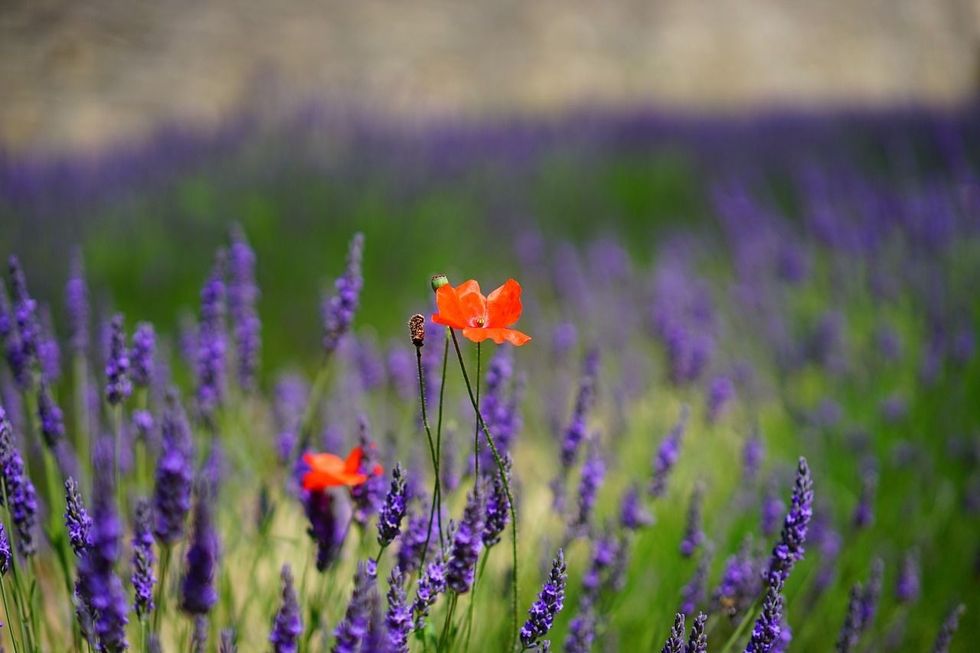Why French flower names?
The French term for a flower is ‘fleur’, with Iris being the national flower of France. Most French names for flowers are quite different from their English term, with accents playing a significant role in correctly pronouncing the names.
French is quite peculiar but is still a sweet-sounding language that adds a subtle sense of intensity to how words are spoken.
It is also one of the most popular foreign languages people across the globe learn, especially in America. A productive way for you or your children to be introduced to the language and practice it would be to learn the French names for random things.
Flower names are also widely used as names for infants. Some popular flowers in France are begonia, geranium, peony, orchid, iris, nasturtium, daffodil, lily, tulip, rose, and iris.
Selecting French flower names to name your boy or girl can make them stand out and signify a deeper meaning.
You can find a wide collection of French names for different flowers and their distinctive characteristics. The descriptions can further help you to learn about the flowers and select a relevant name.
French Flower Names for Girls
1. Ancolie (French origin) - is the colorful, perennial flowering plant ‘columbine’. It is a good name for a calm girl.
2. Anémone (French origin) - is the perennial flowering plant known as ‘windflower’ or ‘anemone’.
3. Bégonia (French origin) - meaning ‘begonia’, is another plant with brightly colored flowers.
4. Bouton d’or (French origin) - is the yellow-colored flowering plant known as ‘buttercup’. You can use the term ‘Bouton’ as a girl’s name.
5. Calla (French origin) - refers to the colorful, South American native flowers, ‘calla lilies’.
6. Campanule (French origin) - refers to the decorative flowers of the ‘bellflower’ plant.
7. Capucine (French origin) - refers to the colorful flowering-bearing plant called ‘nasturtium’.
8. Chèvrefeuille (French origin) - is the name of the ‘honeysuckle’ plant, a creeper functioning as a habitat for small mammals, birds, and insects.
9. Chrysanthème (French origin) - meaning the ‘chrysanthemum’ plant, can be a rare and beautiful name for a girl.
10. Coquelicot (French origin) - referer to the ‘wild poppy’ plants whose flowers come in shades of red and orange.
11. Dahlia (French origin) - refers to the bushy, flowering plant with the same name. Its flowers are formed of many bright petals.
12. Freesia (French origin) - refers to the funnel-shaped, fragrant flowers of the plant of the same name.
13. Gardénia (French origin) - refers to the evergreen flowering shrub called ‘gardenia’.
14. Hibiscus (French origin) - refers to the flowering plant of the same name, known for its large, attractive flowers.
15. Hydrangea (French origin) - the flowering plant is popularly known as ‘hortensia’ and can be either deciduous or evergreen.
16. Iris (French origin) - refers to the plant of the same name, known for its bright-colored, upright flowers.
17. Jacinthe (French origin) - is the name of the bulbous, poisonous flowering plant ‘hyacinth’. As a girl's name, this could signify a strong character.
18. Jasmin (French origin) - refers to the flowering plant of the same name, with both evergreen and deciduous varieties. It is a common name given to girls.
19. Jonquille (French origin) - meaning ‘daffodil’, is a plant with bright, yellow flowers.
20. Lavande (French origin) - meaning ‘lavender’, has purple or lilac-colored.
21. Lys (French origin) - refers to the ‘lily’ plants, which come in various colored flowers. You can use this short and sweet name for a charming little girl.
22. Marguerite (French origin) - meaning ‘daisy’, can be a fitting name for a cheerful girl.
23. Mauve (French origin) - is the name of a sturdy, edible plant known as ‘mallow’, which appears to have small flowers colored white, purple, or pink.
24. Narcisse (French origin) - refers to the genus of perennial flowering plants called ‘narcissus’ that grow tepal instead of petals.
25. Perce-Neige (French origin) - is the name of the ‘snowdrop’ plant that bears white, bell-shaped flowers. It can be a good name for strong girls.
26. Pervenche (French origin) - refers to the plant ‘periwinkle’, which bears colorful, fragrant flowers. You can use this name for your artistic baby girl.
27. Pétunia (French origin) - refers to the plant ‘petunia’, widely known for its flowers.
28. Rose (French origin) - refers to the common flowering plant of the same name. It is a common girl’s name, widely associated with love and passion.
29. Souci (French origin) - is a flowering plant with bright, orange-colored flowers known as ‘marigold’.
30. Tournesol (French origin) - refers to the sun-loving flower known as ‘sunflower’. You can give this name to a girl to remind her to always look at the bright side of things.
31. Tulipe (French origin) - refers to the tropical flowering plant known as ‘tulip’. You could give this name to a cute little girl.
32. Véronique (French origin) - is the name of the plant ‘speedwell’, known for its multiple uses as a cooking ingredient, medicinal herb, or ornamental purposes.
33. Violette (French origin) - meaning ‘violet’, is a small plant with flowers appearing in shades of purple and white.
34. Zinnia (French origin) - refers to flowering plants with the same name. The plant has bright, colorful flowers.
French Flower Names for Boys
35. Acore (French origin) - is the flowering plant ‘sweet flag’ or ‘muskrat root’. You can use this name for a short, sweet boy.
36. Aconit (French origin) - refers to a herbaceous plant called ‘aconite’ or ‘monkshood’, which is quite poisonous.
37. Arum (French origin) - refers to the herbaceous flowering plant of the same name. This is a unique name you can give to your boy.
38. Consoude (French origin) - refers to the perennial, medicinal herb called ‘comfrey’.
39. Crocus (French origin) - refers to the ‘crocus’ or ‘saffron’ plant.
40. Cyclamen (French origin) - refers to a flowering plant of the same name, known for its leaves that have various patterns and flowers that grow vertically up.
41. Gaïeul (French origin) - refers to the plant ‘gladiolus’.
42. Lilas (French origin) - is the name of the flowering shrub ‘lilac’, which has fragrant flowers.
43. Molène (French origin) - is a soft yet sturdy flowering herb known as ‘mullein’, which also has medicinal qualities.
44. Muflier (French origin) - refers to a tall flowering plant, ‘snapdragon’, which grows during spring and summer.
45. Orpin (French origin) - is a herbaceous plant called ‘stonecrop’, which grows in clusters with flowers appearing in shades ofpink, red, purple, yellow, and white.
46. Pavot (French origin) - refers to the ‘poppy’ plant.
47. Primevère (French origin) - meaning ‘primrose’, is one of the first plants to bloom during spring. The name can remind your boy to have a positive attitude.
48. Sauge (French origin) - refers to an evergreen flowering shrub called ‘sage’, which is widely used as a culinary ingredient.
49. Trémière (French origin) - is the name of a tall flowering plant called ‘hollyhock’, known for its long blooming phase.
French Pink Flower Names
50. Asclépiade (French origin) - is the toxic, flowering plant called ‘milkweed’, known for producing complex flowers.
51. Aster (French origin) - is a flowering plant with the same name with small, pink, and purple colored flowers. Aster refers to the star-shaped structure of the flowers.
52. Azalée (French origin) - refers to the ‘azalea’ or ‘rhododendron’ shrub that produces different shades of red and pink flowers.
53. Bruyère (French origin) - is the flowering plant ‘heather’. It mostly produces pink flowers, with some variations of green and white.
54. Chardon (French origin) - refers to the ‘thistle’ plant that bears pink flowers and is distinguishable by its sharp-edged leaves.
55. Cerisier (French origin) - meaning ‘cherry tree’, which produces showy, white, and pink flowers.
56. Daphné (French origin) - refers to the flowering shrub, ‘daphne’, which produces fragrant pink flowers.
57. Fuchsia (French origin) - a flowering plant with the same name that grows as shrubs or small trees and produces vibrant purple and pink flowers.
58. Fumeterre (French origin) - is the ‘fumitory’ plant that generally bears pink or purple flowers and can be used in preparing herbal medicine.
59. Géranium (French origin) - is a plant called ‘geranium’ or ‘cranesbills’, which grows red, purple, but mostly pink colored flowers.
60. Gypsophile (French origin) - refers to the plant known as ‘baby’s breath’, which produces white and pink flowers.
61. Oeillet (French origin) - is the herbaceous flowering plant known as ‘carnation’, commonly found to have pink flowers.
62. Orchidée (French origin) - meaning ‘orchid’, with the prominent most prominent species having pink colored flowers.
63. Pivoine (French origin) - refers to ‘peony’, which produces ball-shaped, red, or pink flowers.
Cute, Pretty French Flower Names
64. Bleuet (French origin) - refers to the ‘cornflower’ plant, whose flowers are worn as pins during specific occasions to commemorate late French soldiers.
65. Cardinaux (French origin) - is the ‘cardinal’ plant that is mainly grown in gardens due to the decorative effect of its showy, red flowers.
66. Chicorée (French origin) - is a herbaceous flowering plant called ‘chicory’, which produces beautiful blue flowers.
67. Colchique (French origin) - is the toxic ‘colchicum’ plant.
68. Coucou (French origin) - refers to the plant ‘cowslip’ that grows in early spring, known for its bright yellow flowers.
69. Digitale (French origin) - is a herbaceous flowering plant called ‘foxglove’, with pink, white, purple, and yellow flowers.
70. Gentiane (French origin) - refers to the ‘gentian’ flowering plant that produces vibrant blue flowers.
71. Giroflée (French origin) - refers to the ‘wallflower’ plant that grows as a shrub or groundcover. Its flowers grow in shades of yellow, red, purple, orange, and blue.
72. Hélénium (French origin) - refers to the plant ‘helenium’, also known as ‘sneezeweed’. It is known for its composite yellow and orange flowers.
73. Magnolia (French origin) - refers to an ancient genus of flowering plants of the same name.
74. Muguet (French origin) - is the flowering plant ‘lily of the valley’ that blooms during spring.
75. Myosotis (French origin) - refers to the herbaceous flowering plant known as ‘forget-me-not’. The flowers have a distinctive yellow center.
76. Pensée (French origin) - refers to the hybrid flowering plant called ‘pansy’. It is known for its peculiar flower arrangement, with petals colored white, purple, blue, or yellow.
77. Pissenlit - refers to the herbaceous plant bearing yellow flowers, ‘dandelion’.
78. Renoncule (French origin) - refers to ‘ranunculus’, a herbaceous plant that bears attractive flowers of different colors.
79. Trompette (French origin) - is a fast-growing, flowering shrub called ‘trumpet’. It produces colorful, scented flowers.
You Might Also Like
New France Facts That You Probably Didn't Know About!
85 Best Flower Jokes For Budding Comedians
Marvelous Marigold Flower Facts That You Will Really Love!








